Just Another One Of Them Cause I Want Too!
Sat Dec 24, 2011 9:41 pm
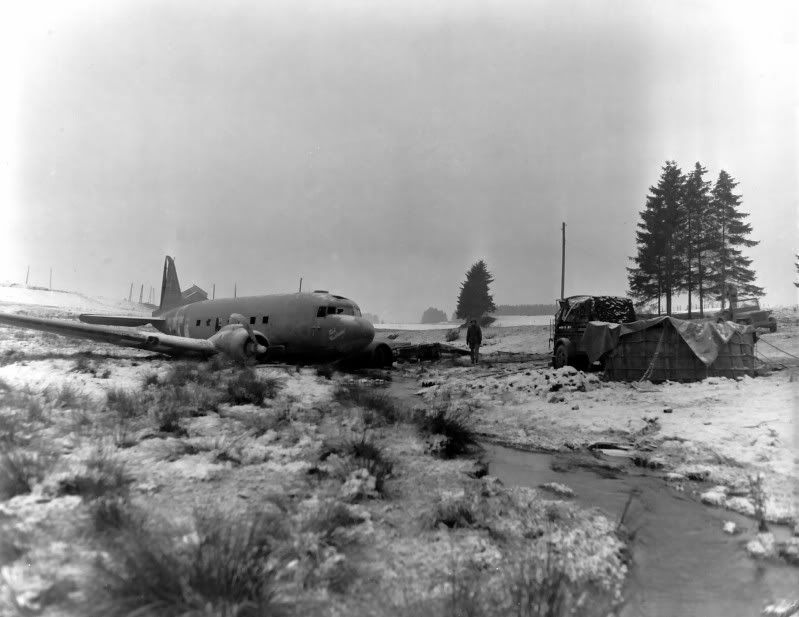 USFG Photo
USFG PhotoThe pilot of a C-47 cargo transport crash lands safely after having dropped supplies to elements of the 101st Airborne Division which has successfully repulsed all attempts to capture the besieged city of Bastogne, Belgium. 30 Dec 1944.
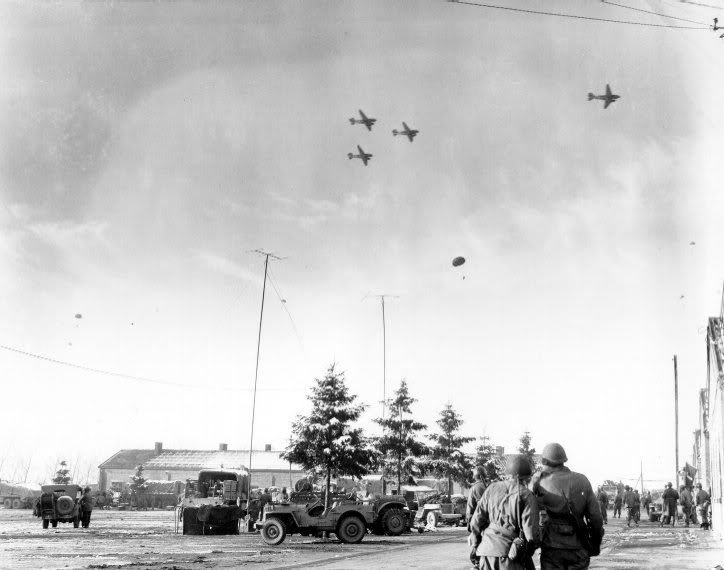 USFG Photo
USFG Photo* Battle of the bulge - Bastogne, Belgium. Troops of the 101st Airborne Division watch C-47’s drop supplies to them. 26 December 1944.
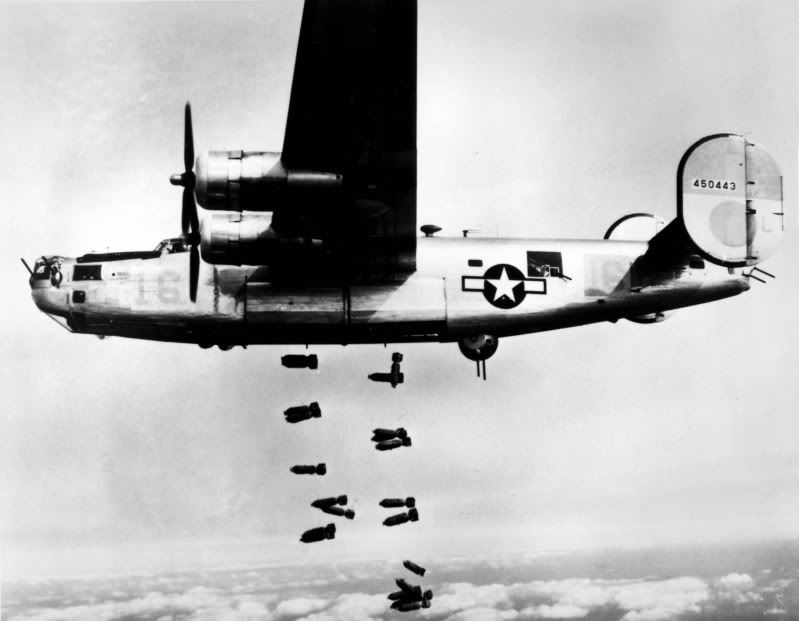 USFG Photo
USFG PhotoA consolidated B-24 Liberator of the 15th A.F. releases its bombs on the railyards at Muhldorf, Germany on 19 March 1945. Bombers of the 15th A.F. are slicing vital rail lines from Vienna to Munich as the air offensive against the enemy reaches an all time high". This plane was assigned to the 451st Bombardment Group, 15th Air Force. It is distinguished by the red upper tailfin over a red circle. 451st Bombardment Group Formed at Davis-Monthan AB, Arizona April 1943. Arrived at Gioia del Colle, Italy January 1944,to San Pancrazio March 1944, to Castelluccio, Italy April 1944. Inactivated September 1945.
 USFG Photo
USFG PhotoRough field operations caused difficult working conditions for 9th Air Force maintenance personnel. Here a crew prepares to use an external heater to warm a P-38’s frozen engine so it can be started while an armorer works on the guns in the nose w(U.S. Air Force photo))hile atop a makeshift stand.
 USFG Photo
USFG PhotoA U.S. Army Air Force Curtiss P-40 Warhawk of the 11th Fighter Squadron, 343rd Fighter Group in Alaska (USA), ca. 1943. The 11th FS moved to Elmendorf Field, Alaska, on 29 December 1941 (with detachments at Fort Randall 25 May to 1 September 1942, and at Ft. Glenn, 26 May to June 1942); in June 1942 the whole squadron moved to Ft. Glenn; on 20 February 1943 it moved to Adak (with detachments at Amchitka, 27 March to 17 May 1943, and 23 March 1944 to 20 July 1945).
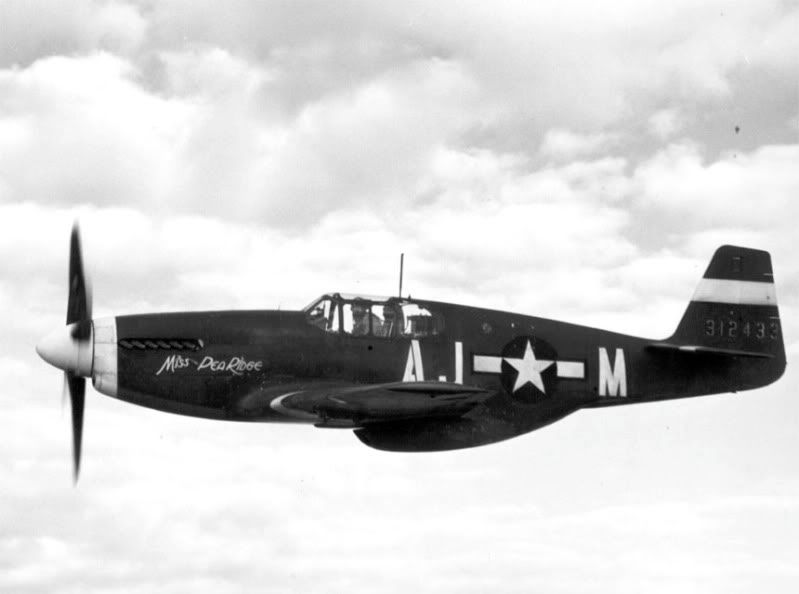 USFG Photo
USFG PhotoA USAAF North American P-51B-1-NA Mustang (s/n 43-12433, code AJ-M) of the 356th Fighter Squadron, 354th Fighter Group, named "Miss Pea Ridge" (pilot Mack Tyner). 42-12433 was originally destined for the Royal Air Force as Mustang Mk III, s/n FX905. It did not serve with the RAF but was returned to the USAAF on 30 December 1943.
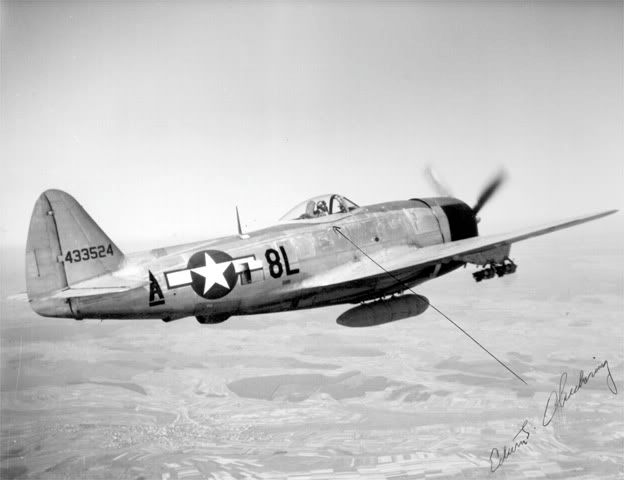 USFG Photo
USFG PhotoA USAAF Republic P-47D-30-RA Thunderbolt (s/n 44-33524, code 8L-A) of the 393rd Fighter Squadron, 367th Fighter Group in flight with belly tank attached and fragmentation bombs on the wings. This aircraft was flown by Col. Edwin S. "Chick" Chickering, who commanded the 367th FG from November 1944 to September 1945 (the photo is signed by him). The 367th Fighter Group transitioned from Lockheed P-38s to the P-47 in early 1945.
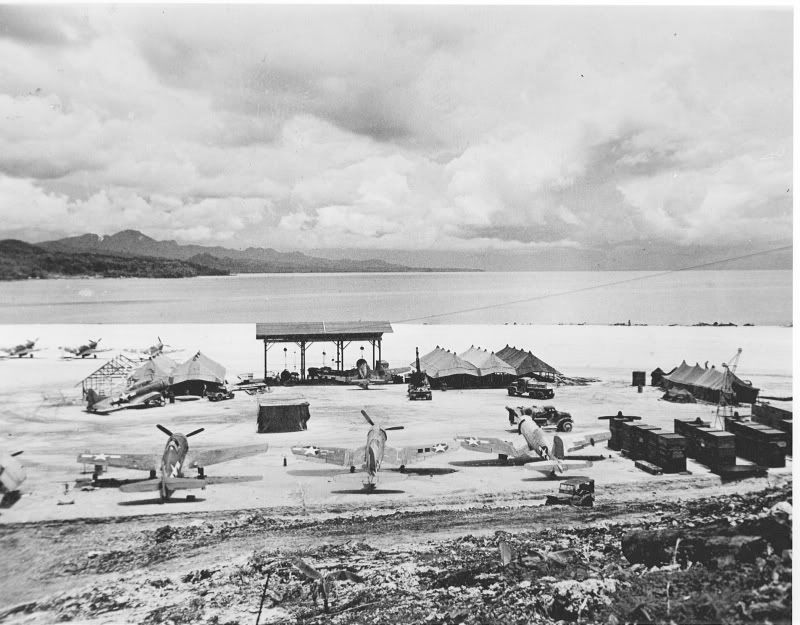 USFG Photo
USFG PhotoVella Lavella airfield in the solomons on 10 December 1943. Visible U.S. Marine Corps Vought F4U-1 Corsair aircraft of Marine fighter squadrons VMF-123 and VMF-124, Grumman F6F-3 Hellcats, a Douglas SBD Dauntless, and RNZAF Curtiss Kittyhawk Mk.IV (P-40F) on the primitive runway at Vella Lavella in the Solomon Islands, which was seized in the summer of 1943 and served as a base of operations to support landings by Allied forces in the Treasury Islands and at Cape Torokina, Bougainville. The swift advance of Allied forces in the South Pacific soon bypassed Vella Lavella and the airfield ceased operations in September 1944, less than a year after the first aircraft arrived.
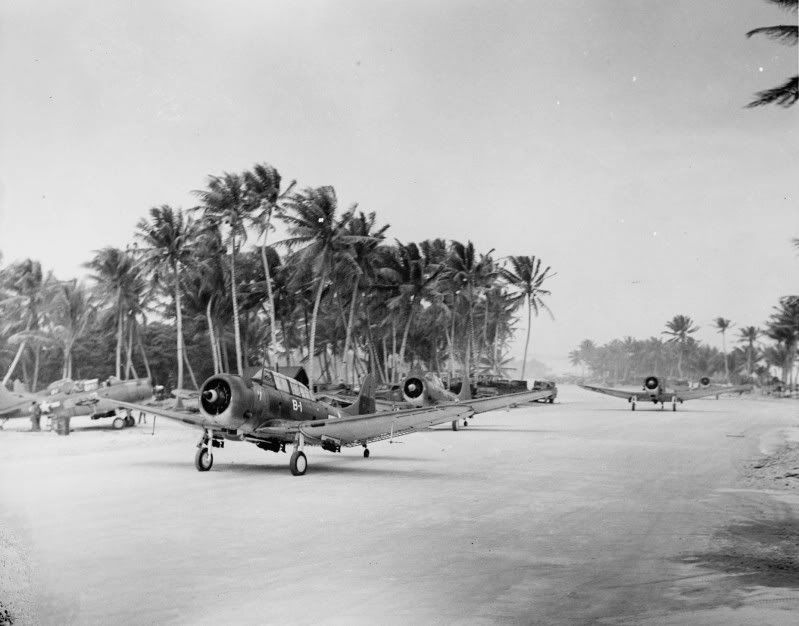 USFG Photo
USFG PhotoU.S. Marine Corps Douglas SBD-5 Dauntless dive bombers of Marine scout-bombing squadron VMSB-231 taxi on the airstrip at Majouro, Marshall Islands, prior to launching on attack against Japanese installations on Mili Atoll (6°7'60N 171°55'0E). Mili was bombed for eighteen months by US aircraft. All supply lines were cut off, and of the originally 5,100 strong Japanese garrison only 2,500 survived, dying mainly from starvation. It was the first Pacific island to surrender on 22 August 1945. Redesignated from Marine Scouting Squadron Two (VMS-2) in July 1941, VMSB-231 aircraft flew to Midway in December 1941, and in March 1942 some elements returned to Hawaii. The remaining personnel formed the nucleus of a new squadron, VMSB-241, which fought during the Battle of Midway in June 1942. Following the battle, the survivors returned to VMSB-231. The squadron arrived at Guadalcanal on 30 August 1942, and remained there until November. Subsequently, the squadron served in the Marshalls, where for a brief time it flew F4U Corsairs under the designation VMBF-231. The squadron was redesignated VMTB-231 in August 1945.
 USFG Photo
USFG Photo"MY GIRL" -- A North American P-51 takes off from Iwo Jima, in the Bonin Islands. From this hard-won base our fighters escorted the B-29's on bombing missions to Japan, and also attacked the Empire on their own.
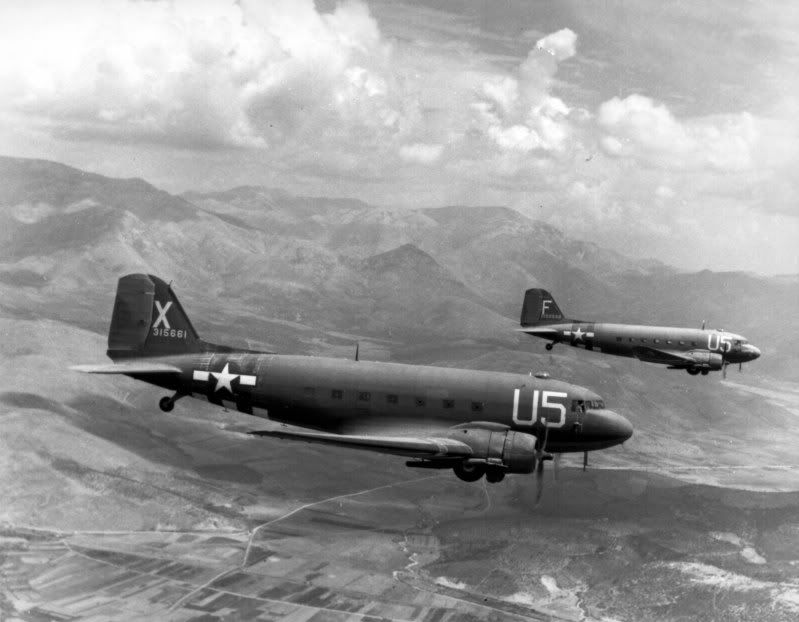 USFG Photo
USFG PhotoTwo USAAF C-47A Skytrains (based on the Douglas DC-3) from the 12th Troop Carrier Wing, loaded with paratroopers on their way for the invasion of southern France (Operation Dragoon). The aircraft in the back is a Douglas C-47A-65-DL (s/n 42-100550), the other is a C-47A-90-DL (s/n 43-15661). Date 15 August 1944(1944-08-15)
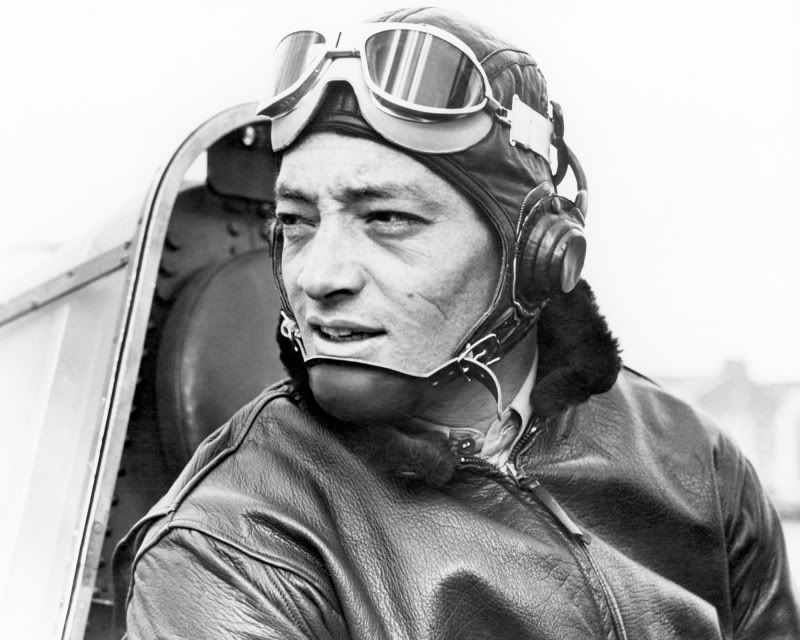 USFG Photo
USFG PhotoWorld War II (WWII) area photograph of US Marine Corps (USMC) Major (MAJ), John L. Smith, taken February 1943. MAJ Smith was awarded the Medal of Honor and is an Ace Pilot credited with 19 kills.
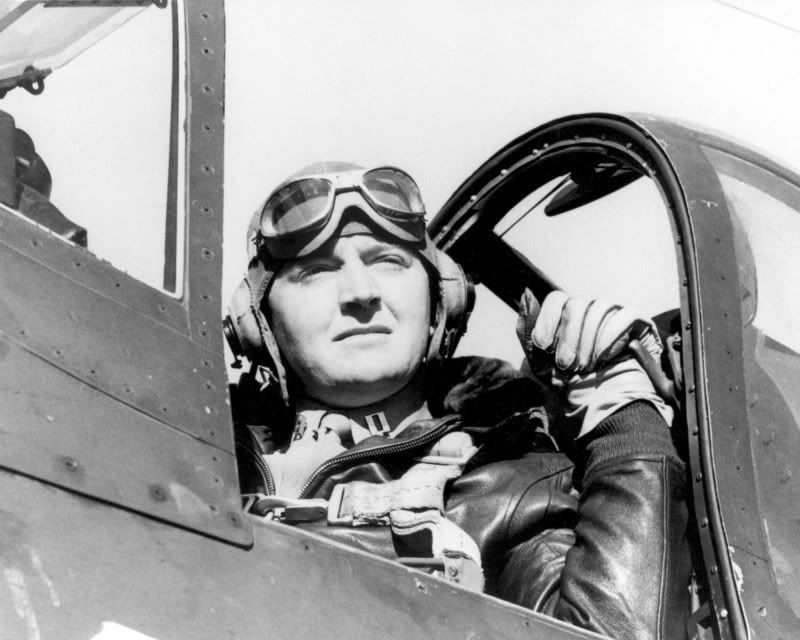 USFG Photo
USFG PhotoWorld War II (WWII) area photograph of US Marine Corps (USMC) First Lieutenant (1LT) William B. Freeman, taken at North Island, San Diego, California (CA), 1943. 1LT Freeman is a World War II (WWII) Ace Pilot credited with 6 kills.
 USFG Photo
USFG PhotoNose detail of Boeing B-17E "Typhoon McGoon II" (S/N 41-9211) of the 11th Bomb Group, 98th Bomb Squadron, taken in January 1943 in New Caledonia. Note the antennas mounted above the nose plexiglass used for radar tracking of surface vessels.
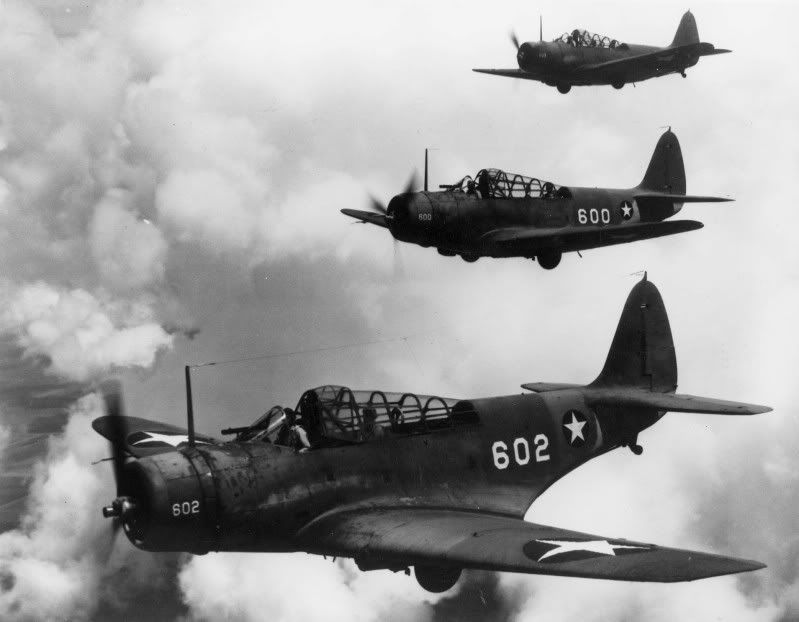 USFG Photo
USFG PhotoMiami, Florida (USA), in flight over South Florida, 1942/43. NAS Miami and NAS Ft. Lauderdale were home to Operational Training Units for the instruction of U.S. Navy torpedo-bomber pilots. The last TBD was retired in early 1944.
======================================================


Re: Just Another One Of Them Cause I Want Too!
Sat Dec 24, 2011 10:19 pm
Thanks for the pictures very cool. 

Re: Just Another One Of Them Cause I Want Too!
Sat Dec 24, 2011 10:30 pm
Good post, thanks! 
Re: Just Another One Of Them Cause I Want Too!
Sun Dec 25, 2011 9:46 pm
According to the book "Fortress Against the Sun" the B-17 "Typhoon McGoon II" was returned to the US on 14 Dec 1945. Wonder where she ended up?
Re: Just Another One Of Them Cause I Want Too!
Sun Dec 25, 2011 9:53 pm
Great photos and even better, informative text adding to each.
Thanks for the Warbird Information!
Thanks for the Warbird Information!
Re: Just Another One Of Them Cause I Want Too!
Sun Dec 25, 2011 10:32 pm
As a 1 quart sauce pan
Re: Just Another One Of Them Cause I Want Too!
Sun Dec 25, 2011 11:36 pm
67N20 wrote:According to the book "Fortress Against the Sun" the B-17 "Typhoon McGoon II" was returned to the US on 14 Dec 1945. Wonder where she ended up?
Freeman gives the history as follows; the thirty-fifth-from-last B-17E, 41-9211 delivered Cheyenne 22 May 1942, assigned to the 98th Bomb Squadron, 11th Bomb Group in Hawaii. Flew in Guadalcanal, from January 1943. Returned to the US, to 901 Base Unit Orlando, Florida 14 December 1945. No further history noted. Freeman usually notes the Reclamation Finance Center information for those aircraft sold for scrap after the war, so this machine may have been broken up by the military, rather than going for tender as scrap.
Interestingly, this aircraft was the next one after 41-9210, which survived postwar service in Canada and Bolivian meat haulage to return to the US, now being in Paul Allen's collection.
Cheers,
Matt
Re: Just Another One Of Them Cause I Want Too!
Mon Dec 26, 2011 12:08 am
I'm co-author of a book ('HELL HAWKS!") about a P-47 Thunderbolt fighter group and I'm especially curious about the beautiful photo of Chickering's P-47. I've seen many references to Chickering and to his flying several types of fighters, including P-39 Airacobras in the Aleutians and reconnaissance aircraft in the postwar era. Yet I've never seen a biography of Chickering or an appreciation of what must have been a very rich and interesting life. The P-47 photo is a new image to me. It's a great shot.
Re: Just Another One Of Them Cause I Want Too!
Mon Dec 26, 2011 1:02 am
Interesting looking at the two C 47's from August 44 where the invasion stripes have already pretty much washed off.
Re: Just Another One Of Them Cause I Want Too!
Mon Dec 26, 2011 2:38 pm
robertfdorr wrote:I'm co-author of a book ('heck HAWKS!") about a P-47 Thunderbolt fighter group and I'm especially curious about the beautiful photo of Chickering's P-47. I've seen many references to Chickering and to his flying several types of fighters, including P-39 Airacobras in the Aleutians and reconnaissance aircraft in the postwar era. Yet I've never seen a biography of Chickering or an appreciation of what must have been a very rich and interesting life. The P-47 photo is a new image to me. It's a great shot.
Mr Dorr, thank you for your reply. The pics I put up, for the most part are "Public Domain" from Wiki Commons. I was just lucky enough to run across the photo several years ago.
Best Regards
Robbie
